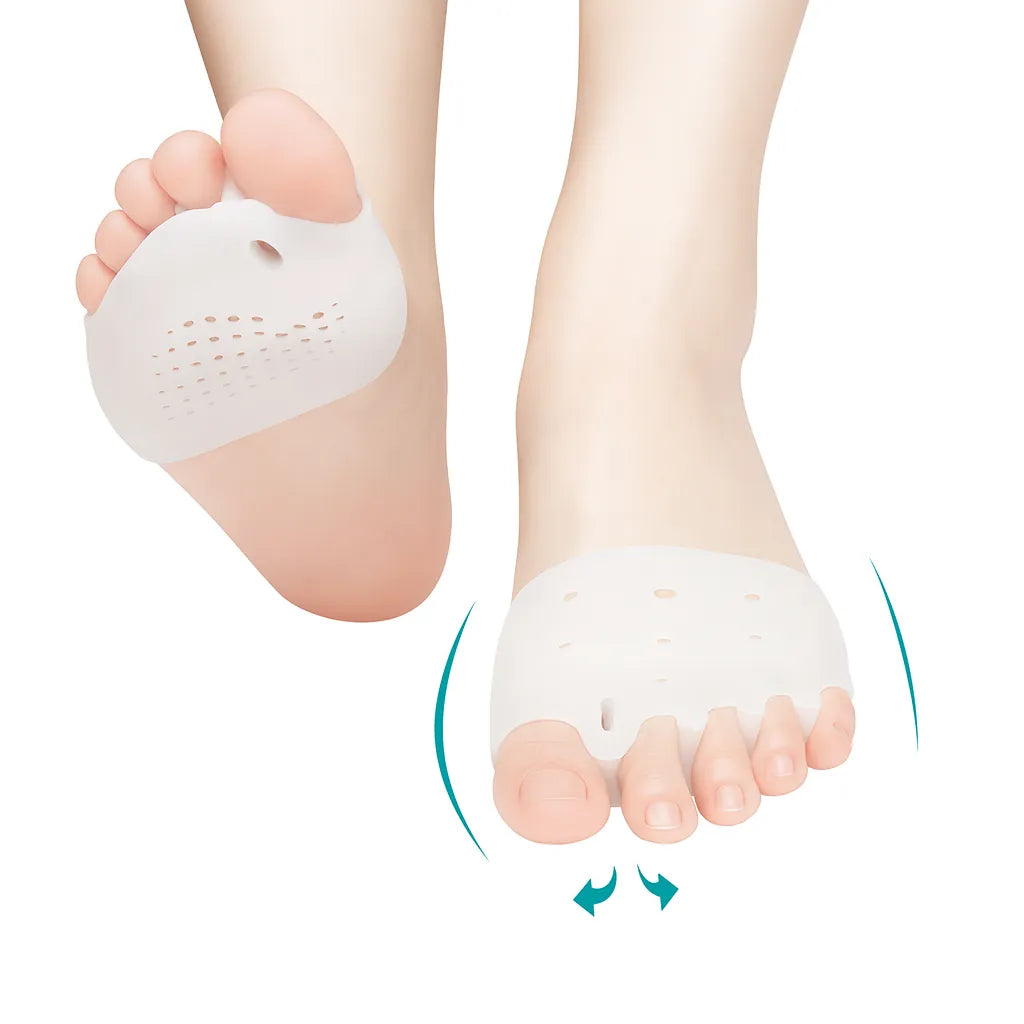
Success Stories: Overcoming Severe Plantar Fasciitis
Share
Overcoming Plantar Fasciitis: A Success Story
Severe plantar fasciitis can be a debilitating condition that affects daily life. The excruciating pain in the heel and foot makes even simple tasks seem impossible. From walking to standing, every step becomes a challenge. But amidst this struggle, there is hope. We will also uncover the importance of finding effective treatment options and share inspiring success stories of individuals who have triumphed over severe plantar fasciitis. Get ready to be inspired!
Case Study: Effective Treatment for Chronic Plantar Fasciitis
Real-Life Success Story
Let's dive into a real-life case study that highlights the effectiveness of various treatment methods for chronic plantar fasciitis. This case study will provide insights into different approaches used to manage this condition and demonstrate the positive outcomes achieved through tailored treatment plans.
Tailored Treatment Approaches
There are several treatment options available. Conservative treatments such as physical therapy, stretching exercises, orthotic devices, and footwear modifications are often recommended as initial steps. These methods aim to reduce pain and inflammation while improving foot mechanics.
Shockwave Therapy: A Game-Changer
In some cases where conservative treatments fail to provide relief, shockwave therapy emerges as a game-changer. This non-invasive procedure involves delivering high-energy sound waves to the affected area, stimulating healing and reducing pain. Many patients have reported significant improvement after undergoing shockwave therapy.
Comprehensive Approach for Long-Term Relief
To achieve long-term relief from chronic plantar fasciitis, a comprehensive approach is crucial. This includes combining conservative treatments with shockwave therapy or other advanced interventions based on individual needs. By addressing both the symptoms and underlying causes of plantar fasciitis, this comprehensive approach offers the best chance for successful management.
The Importance of Seeking Professional Help
Why Consult Healthcare Professionals for Plantar Fasciitis
Seeking professional help is crucial. Healthcare professionals have the expertise and knowledge needed to accurately diagnose and treat this condition. They can provide valuable insights into the best course of action for managing and overcoming plantar fasciitis.
The Expertise and Knowledge of Professionals
Healthcare professionals, such as doctors, physical therapists, and podiatrists, bring a wealth of experience to the table. They have studied the human body extensively and understand the complexities of this condition. By consulting with them, patients can benefit from their specialized knowledge in identifying underlying causes, providing effective therapy options, and guiding individuals through the recovery process.
Accurate Diagnosis and Treatment
One of the main advantages of seeking professional help is obtaining an accurate diagnosis. While temporary relief measures like stretching exercises or over-the-counter pain medications may provide some respite, they do not address the root cause of plantar fasciitis. Only a healthcare professional can conduct a thorough examination, review medical history, perform diagnostic tests if necessary, and develop a tailored treatment plan that addresses individual needs.

Timely Medical Assistance to Avoid Complications
Ignoring severe plantar fasciitis or attempting self-treatment without professional guidance can lead to further complications. Without proper intervention, symptoms may worsen over time or become chronic. Seeking timely medical assistance ensures that appropriate steps are taken early on to prevent long-term issues that could impact daily life activities such as work or exercise.
Managing Pain: Utilizing Walking Boot and Exercise
Walking Boots: Support and Alleviation
Walking boots can be a game-changer. These orthotic devices provide the necessary support and stability to your feet, reducing the strain on the affected areas. By immobilizing the foot and ankle, walking boots help alleviate pain during daily activities.
Pros:
- Provides support to the arches of the foot.
- Reduces pressure on the heel.
- Allows for better mobility while protecting the injured area.
Cons:
- May cause discomfort or irritation if not fitted properly.
- Can limit flexibility and range of motion.
- Requires adjustment period for adaptation.
Exercises: Strengthening Muscles and Reducing Discomfort
In addition to using walking boots, incorporating specific exercises into your routine can further aid in managing plantar fasciitis pain. These exercises aim to strengthen the muscles in your feet, calves, and ankles while improving flexibility.
Examples of beneficial exercises include:
Calf stretches: Gently stretching your calf muscles helps relieve tension on the plantar fascia.
Toe curls: Picking up small objects with your toes strengthens the muscles in your feet.
Ankle circles: Rotating your ankles clockwise and counterclockwise improves joint mobility.
Rest, Stretching, and Physical Therapy: Essential Components
While utilizing walking boots and performing exercises are crucial steps, it's important not to overlook rest, stretching, and physical therapy as part of an effective pain management strategy.
Key points to consider:
- Resting allows time for healing and prevents further aggravation.
- Stretching exercises specifically targeting tight calf muscles can alleviate strain on the plantar fascia.
- Physical therapy sessions may include techniques such as ultrasound therapy or shockwave therapy to promote healing.
By combining these approaches along with proper footwear, such as supportive running shoes or custom orthotics, individuals can significantly reduce pain and improve their quality of life while dealing with severe plantar fasciitis.
Post-Surgery Complications: Recurring Problems and Solutions
After undergoing surgery for plantar fasciitis, it's important to be aware of the potential complications that may arise during the recovery process. Despite surgical intervention, some individuals may still experience recurring problems.
Recognize Common Complications
Swelling: It is common to experience swelling after surgery. This can cause discomfort and delay the healing process.
Drug Allergies: Some individuals may have allergic reactions to medications prescribed during their recovery. It's crucial to communicate any known drug allergies with your healthcare provider.
Recurrence of Symptoms: Despite surgery, there is a possibility that plantar fasciitis symptoms may return or persist.
Understand Why Recurring Problems Occur
Incomplete Healing: The healing process after surgery varies from person to person. Sometimes, the plantar fascia does not fully heal or regenerates in a way that causes continued pain.
Overuse or Improper Footwear: Engaging in activities that put excessive strain on the foot or wearing improper footwear can lead to recurring problems.
Explore Potential Solutions
Revision Surgery: In cases where initial surgery did not provide the desired outcome, revision surgery might be considered as an option.
Alternative Treatments: Non-surgical options such as physical therapy, orthotics, shockwave therapy, or corticosteroid injections could be explored for managing persistent symptoms.
Post-Surgery Care
Follow Rehabilitation Guidelines: Adhering to post-surgery rehabilitation guidelines provided by your healthcare professional can help minimize complications and promote successful recovery.
Monitor Symptoms: Regularly check for any signs of recurring problems or new symptoms and promptly report them to your healthcare provider.
Understanding the potential complications post-surgery allows you to be prepared and take necessary steps to address any recurring problems. By staying proactive and following proper post-surgery care, you can increase the chances of a successful recovery.
DVT Risk after Instep Plantar Fasciotomy: A Critical Reminder
Risk of Deep Vein Thrombosis (DVT)
After undergoing instep plantar fasciotomy surgery, it is crucial to be aware of the potential risk of developing deep vein thrombosis (DVT). DVT occurs when blood clots form in the deep veins, typically in the legs.
Recognizing and Addressing DVT Symptoms
It is essential to promptly recognize and address any symptoms that may indicate the presence of DVT. Some common signs include swelling, pain, warmth, and redness in the affected leg. If you experience these symptoms or have concerns, it is vital to consult your healthcare provider immediately.
Preventive Measures to Reduce DVT Risk
To reduce the risk of developing DVT after surgery, there are several preventive measures you can take:
Stay active: Engaging in regular physical activity encourages healthy blood circulation.
Wear compression stockings: These specialized stockings help promote blood flow and prevent clot formation.
Stay hydrated: Drinking an adequate amount of water helps maintain proper blood viscosity.
Follow post-operative instructions: Adhering to your surgeon's recommendations regarding mobility and exercise can minimize the risk of complications.
Importance of Post-operative Monitoring
Post-operative monitoring plays a significant role in early detection and intervention for potential complications such as DVT. Regular check-ups with your healthcare provider allow them to assess your progress, monitor for any signs of complications, and provide appropriate guidance if needed.
By understanding the risks associated with DVT following instep plantar fasciotomy surgery and taking necessary precautions, you can significantly reduce the likelihood of developing this condition. Remember to stay vigilant about any unusual symptoms or discomfort during your recovery period.
Inspiring Success Stories in Plantar Fasciitis Recovery
Congratulations on making it to the end of this blog post! By now, you've learned about effective treatments for chronic plantar fasciitis, the importance of seeking professional help, managing pain through walking boot and exercise, and even how to deal with post-surgery complications. But let's not forget that recovery is possible. Countless individuals have triumphed over severe plantar fasciitis, and their success stories can inspire you too.
If you're feeling discouraged or overwhelmed by your plantar fasciitis journey, remember that you are not alone. Many others have faced similar challenges and come out stronger on the other side. Their stories serve as a reminder that with determination, proper treatment, and a positive mindset, overcoming plantar fasciitis is within reach.
Now that you've gained valuable insights into plantar fasciitis recovery from real-life experiences and expert advice, take action! Consult with a healthcare professional to create an individualized treatment plan tailored to your needs. Remember to be patient with yourself throughout the process – healing takes time. With perseverance and the right support system in place, you can conquer plantar fasciitis and get back on your feet again.
FAQs
- How long does it take to recover from severe plantar fasciitis?
Recovery time can vary depending on the severity of your condition and the treatments utilized. In general, mild cases of plantar fasciitis may resolve within a few weeks or months with conservative measures such as rest, stretching exercises, orthotic inserts, and physical therapy. However, more severe cases might require longer recovery periods ranging from several months to even a year or more.
- Can I continue exercising while recovering from plantar fasciitis?
It's essential to listen to your body and to your healthcare provider while recovering from plantar fasciitis. While some forms of exercise may need to be modified or temporarily avoided, low-impact activities like swimming, cycling, and yoga can often be continued during recovery. Consult with a healthcare professional for personalized advice on which exercises are safe for you.
- Are there any natural remedies that can help with plantar fasciitis pain?
While there is limited scientific evidence supporting the effectiveness of natural remedies for plantar fasciitis, some individuals find relief from using ice packs, applying essential oils topically, or utilizing over-the-counter arch supports or heel cushions. However, it's crucial to remember that what works for one person may not work for another. Consult with a healthcare professional before trying any natural remedies.
- Can wearing high heels cause plantar fasciitis?
Wearing high heels regularly can contribute to the development of plantar fasciitis by placing excessive strain on the foot's arch and heel. The unnatural position of the foot in high heels can lead to tight calf muscles and increased pressure on the plantar fascia. Opting for more supportive footwear with proper arch support and cushioning is advisable to prevent or alleviate plantar fasciitis symptoms.
- Is surgery necessary to treat severe plantar fasciitis?
Surgery is typically considered a last resort when conservative treatments fail to provide relief after an extended period. Most cases of severe plantar fasciitis respond well to non-surgical interventions such as physical therapy, orthotics, night splints, corticosteroid injections, and extracorporeal shockwave therapy (ESWT). Only in rare instances where all other options have been exhausted would surgery be recommended by a healthcare professional.
Remember that these FAQs serve as general guidance and should not replace personalized advice from a medical professional.
Author Bio

Inês Pinheiro
Certified Physiotherapist for Shoulder and Knee Injuries
Inês is a skilled physical therapist with a special interest and extensive experience in working with athletes, specifically football players and also neurologic patients.













